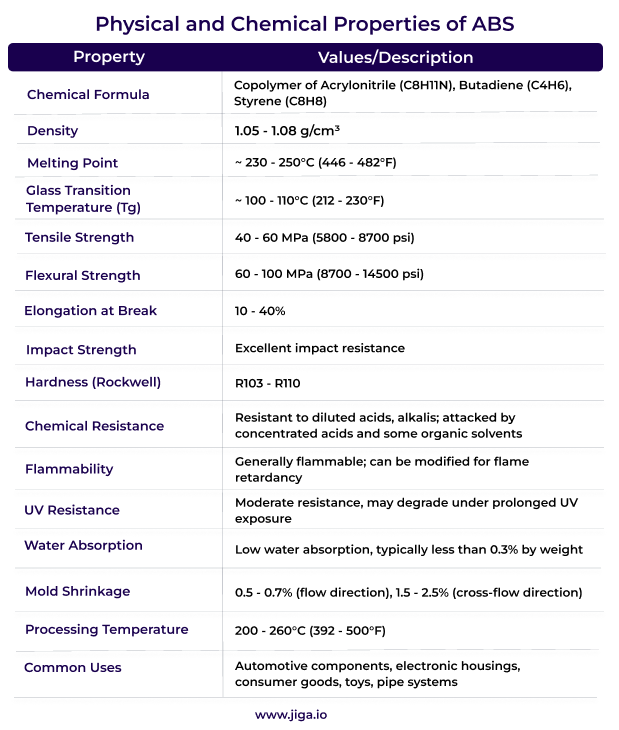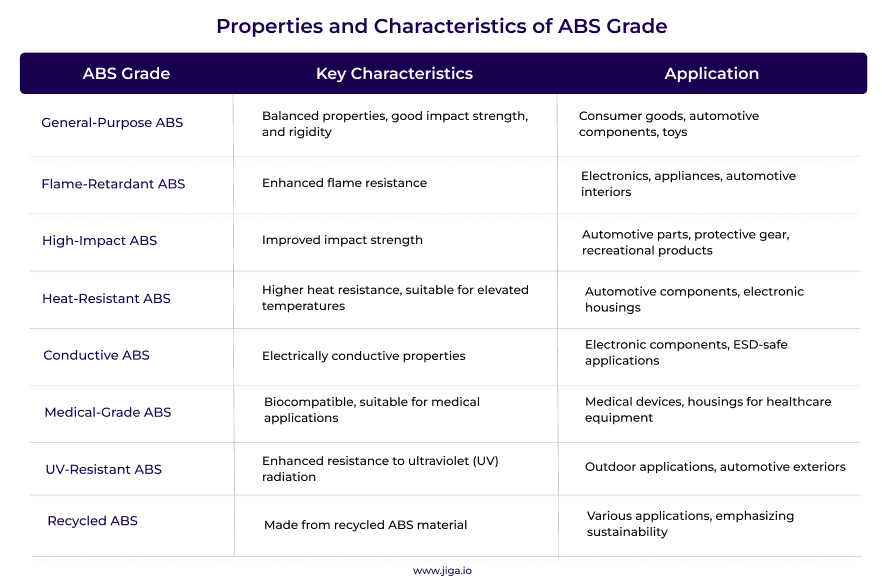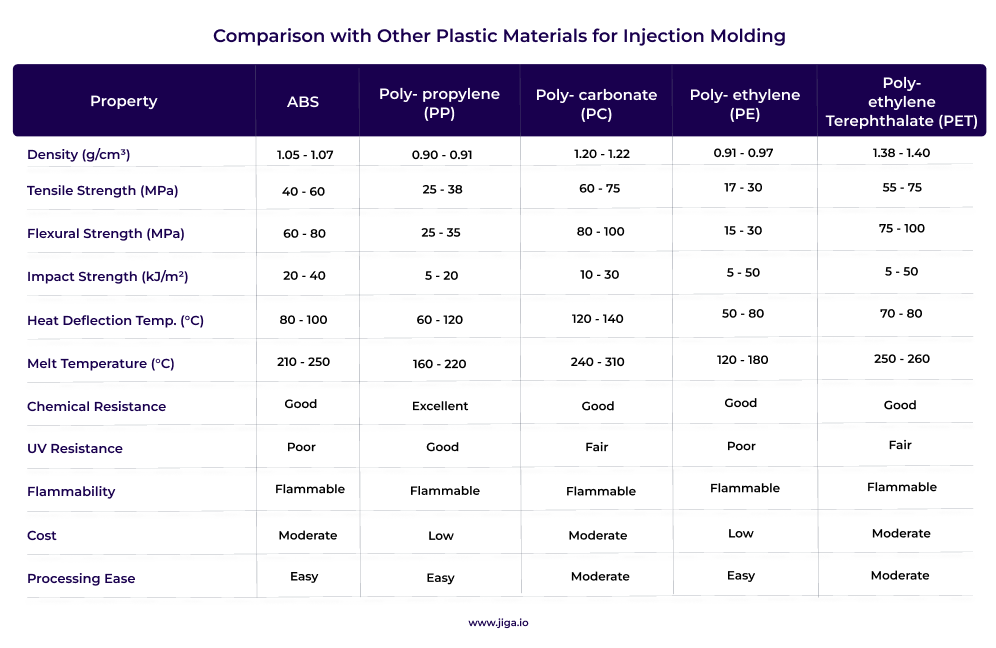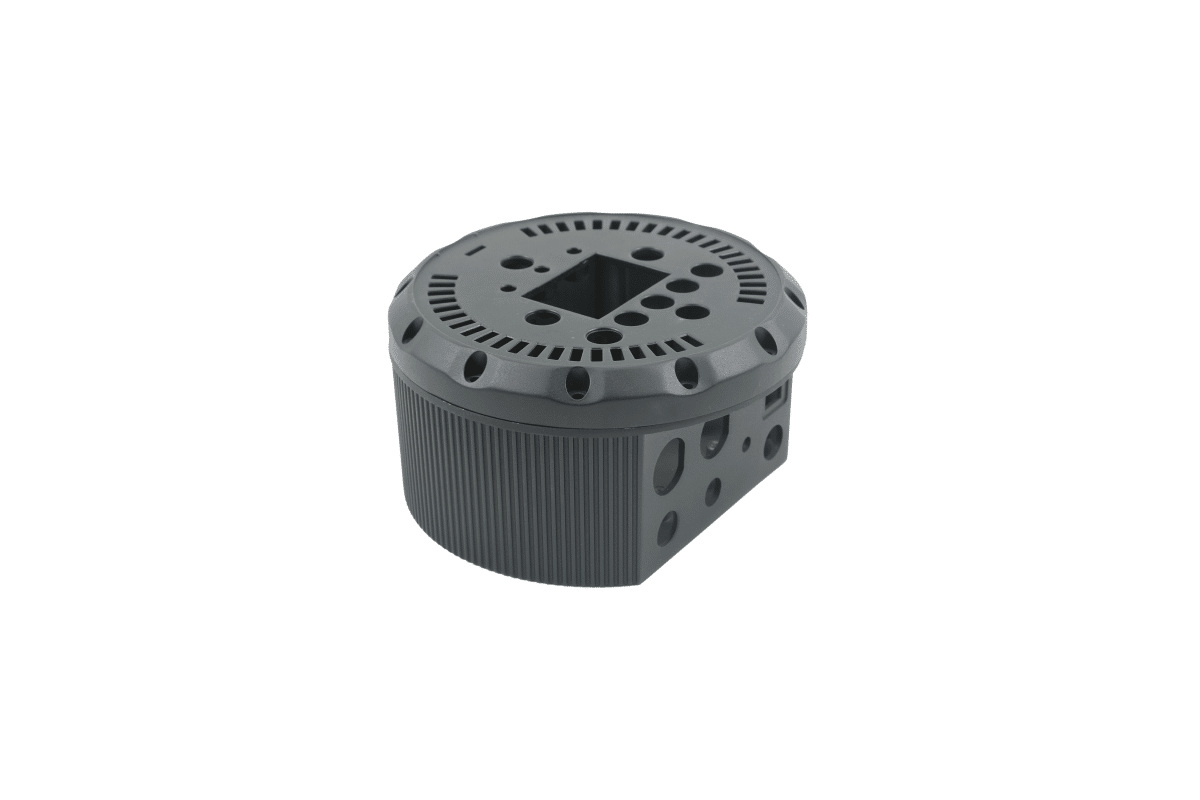ABS injection molding refers to the process of manufacturing plastic products using Acrylonitrile Butadiene Styrene (ABS), a thermoplastic polymer known for its strength, impact resistance and versatility in diverse technical and cosmetic applications.
ABS resin granules are heated until they become molten, then the fluid is injected into a mold cavity under high pressure. The molten ABS conforms to the shape of the mold and progressively solidifies as it cools. This results in the desired plastic product, which will be a faithful reproduction of the cavity of appropriate molding parameters have been adhered to.
ABS injection molded parts are widely exploited across all industries for producing items as diverse as automotive components and body panels, electronic housings, consumer goods, medical appliances, furniture and toys. This diversity results from the polymer’s favorable balance of mechanical and manufacturing characteristics.
Importance and applications of ABS Injection Molding
ABS injection molding is of central importance in the manufacturing sector, due to the versatility and desirable properties. It is appreciated and widely used for its strength, impact resilience, heat stability and ease of processing for high quality and high cosmetic outcomes. ABS Injection molding facilitates easy and low cost production of intricate and complex net-shape components that are durable, lightweight and attractive looking.
Applications of ABS injection molding span almost all industries.
- In the automotive sector, ABS is utilized for interior components, dashboards, and exterior trims and large bumper moldings.
- Consumer electronics product housings and functional parts benefit from ABS’s good cosmetics, low cost and general toughness.
- Toys, kitchen appliances and sporting equipment often feature ABS parts, chosen for durability and aesthetic appeal.
The process enables the production of high-quality, consistent parts at scale, making ABS injection molding crucial in much of the product manufacturing spectrum.
Material Properties of ABS
ABS is a versatile thermoplastic polymer, offering a balance of strength, impact resilience, good cosmetics and ease of processing. ABS exhibits a balanced combination of the mechanical and thermal properties of its copolymer constituents.
Here’s a table summarizing the physical and chemical properties of ABS);

Impact strength and toughness
ABS is renowned for its exceptional impact strength and toughness, making it a preferred choice in various applications, exhibiting a balance of rigidity and flexibility. This enables it to absorb and resist impact forces and undergo considerable distortion without undergoing significant deformation or breakage, returning to its original shape.
This outstanding impact resistance is especially beneficial in applications where durability and reliability are critical, such as automotive paneling/bumpers and consumer goods. The toughness of ABS is attributed to its unique composition, formed by copolymerization of 2 highly elastic rubbers and very rigid styrene. This combination renders it suitable for diverse engineering and manufacturing challenges
Heat resistance and flame retardancy
ABS offers moderate heat resistance. It has a glass transition temperature (Tg) typically ranging from 100 to 110°C (212 to 230°F). Above Tg it becomes increasingly soft and highly deformable. It is not suitable for prolonged exposure to high temperatures.
ABS is inherently highly flammable, but incorporating flame retardant additives during the manufacturing process improves this by inducing self extinguishing behavior. Flame-retardant ABS is often used in applications where fire safety is a concern, such as electronics and automotive components.
High gloss and aesthetic appeal
ABS can deliver a high-gloss finish for good aesthetic appeal. ABS can be manufactured with various surface textures from glossy to highly textured surfaces, faithfully reflecting the mold surface.
ABS can be masterbatched in a wide spectrum of colors, allowing for customization and aesthetic versatility

George B

CTO
"Hands-Down the Best Platform and Partner for Fast, Quality Parts"
Jiga is the best way to get the parts you need, when you need them.
Injection Molding Process
Injection molding is a widely employed and critically important manufacturing process for ABS. It consists of melting polymer granules and injecting the resultant fluid into a mold tool, under high pressure.
- ABS resin pellets are hoppered into the heated barrel of an injection molding machine, where the resin melts and is continuously stirred to maintain optimal and uniform temperature.
- The charge is then introduced under pressure into a mold tool, where the polymer cools and solidifies to a more or less faithful reflection of the cavity shape.
- The tool is an openable aperture in a steel mold tool that is pressured closed by an hydraulic or electric ram, and opened after molding to extract the finished part.
Role of ABS in injection molding
ABS is a key material in the injection molding sector, offering a range of properties that make it optimal for this manufacturing method.
- ABS is highly moldable, allowing it to be formed into complex net-shape parts.
- Its low melt-viscosity facilitates the filling of the mold cavities precisely and faithfully.
- ABS has beneficial processing characteristics, making it compatible with the high-speed and high-volume nature of injection molding.
- ABS has applicability to a spectrum of applications due to its range of properties, making it suitable for manufacturing products, from automotive components and electronic housings to consumer goods.
- One of ABS’s notable features is its astonishing impact resistance. It’s so tough that car bumpers are designed for near zero damage in 5 mph impacts with smooth/blunt surfaces.
- ABS can achieve a smooth and glossy surface finish for high aesthetic appeal.
- It is available in all colors, allowing manufacturers to produce parts requiring no further finishing.
- ABS possesses good resistance to mild chemicals, though it performs poorly in aggressive or solvent heavy environments.
- It maintains good dimensional stability during and after the injection molding process.
- It is cost-effective and offers great economy of scale, being a highly competitive and commoditized raw material.
- It is highly recyclable, particularly when effectively sorted, and can be returned to premium grade use.
Mold temperature and its impact on ABS injection molding
Mold temperature is perhaps the most critical parameter in injection molding;
- Mold temperature affects the injection flowrate. Hotter injection (within parameters) improves quality, cooler injection improves productivity. Quality results from balancing these pressures.
- Mold temperature influences the cooling rate of the material. Uniform and moderate cooling prevents warpage and improves dimensional stability.
- Mold temperature affects the surface finish of the part. Higher mold temperatures often result in a glossy surface finish, influencing part quality.
- Rapid cooling can create internal stresses, leading to immediate or later distortion and loss of precision.
- Mold temperature impacts cycle times, so appropriate temperature balance helps achieve efficient cooling, improving production efficiency.
- Mold temperature influences the flow behavior within the mold cavity, affecting the filling of intricate mold features.
- Consistent mold temperatures contribute to the reproducibility of injection molding processes.
- Mold temperature can influence the crystallinity of the polymer and, consequently, its stiffness and impact resistance.
- Controlling mold temperature is essential for energy efficiency. Hotter running increases waste and cost.
Mold shrinkage and its effect on part dimensions
Mold shrinkage results during the cooling phase of the polymer, causing reduction in solidified dimensions of plastic parts. Understanding and compensating/countering mold shrinkage is a key skill in designing molds.
Mold shrinkage causes the ABS to shrink in size as it solidifies.
- Mold shrinkage introduces a discrepancy between the dimensions of the mold and the final part. Tool cavities are cut oversize to compensate for shrinkage.
- Molding pressure is also retained during cooling, to compensate for this shrinkage.
- The shrinkage rate of ABS varies between grades, with processing conditions and part geometry. Manufacturers typically provide shrinkage values for specific grades.
- Uneven cooling can lead to warping or localized distortion in the molded part. Optimizing cooling channels can influence this fault.
- Designers consider tolerances in the mold to compensate for the expected shrinkage. This ensures that the final ABS part meets dimensional requirements. Fine features cannot be flow fed to compensate, so must be molded in over-size cavity areas.
- Once the part is ejected from the cavity, additional dimensional changes may occur due to further cooling which must be considered in the overall part and tool design.
Understanding and managing mold shrinkage is a critical aspect of successful injection molding with ABS.
Wall thickness considerations for ABS parts
Wall thickness is a crucial design consideration for ABS parts in injection molding. Appropriate wall thickness ensures structural integrity, dimensional stability, moldability and efficient manufacturing.
- Maintaining uniform wall thickness throughout the part reduces uneven cooling, warping etc.
- Adequate wall thickness allows for smooth and unrestricted material flow during injection molding, reducing defects.
- Sufficient wall thickness contributes to the strength and stiffness of parts.
- Thin walls cool rapidly, while thick walls take longer and the difference can induce warping.
- Rounded corners and filets enhance material flow, reducing the risk of stress concentration and disrupted flow/regional crystallization changes.
- For larger parts, thicker walls may be necessary to provide the required structural integrity. Smaller parts can often have thinner walls.
- Design for manufacturability considers the limitations and capabilities of injection molding processes.
- Uneven wall thickness will cause sink marks, where good design aims for smooth transitions where thickness changes are required.
- Longer flow paths require thicker walls to ensure proper material flow without premature solidification. Integrating feeder ribs/runners into the part can help with this.
- Maintain good aspect ratios to avoid issues like warping and sink marks and uneven cooling.
- Use ribs and reinforcements to enhance the strength of the part cautiously, ensuring designs avoid complications like sink marks.
- Consider the expected tolerances and shrinkage rates during mold design, to ensure part tolerances requirements don’t cause extreme manufacturing issues.
Draft angle requirements for easy part ejection
Draft angles are applied to surfaces that are close to parallel with the axis of the tool’s opening. They facilitate the easy ejection of a molded part from the mold cavity, without high forces and scuffing, as parallel surfaces slide over the tool. Designing with appropriate draft angles is crucial for smooth ejection and minimizing the risk of damage, and it requires experience to understand the limitations and risks.
- A standard draft angle for ABS parts is about 1 to 2 degrees. This varies with part geometry, size and the surface finish which could increase drag.
- Smoother surface finishes generally require smaller draft angles. Textured or matte finishes require greater draft to ensure the surface releases and slides without scuffing or sticking.
- Tall, thin walls may require larger draft angles to ensure easy ejection. They can also benefit greatly from polishing to ease release.
- Deep pockets or sharp corners may need additional draft to facilitate ejection.
- Material characteristics, including shrinkage rates, flexibility and adhesion to the mold surface can influence the required draft angle.
- Mold release agents can assist with part ejection, however this can have quality implications and must be considered carefully.
- Larger parts can benefit from increased draft angles, to compensate for increased surface area and adhesion potential.
- Blanking areas (where sliders meet main tool faces at undercuts) will require localized increases in draft angles.
- Follow broadly published design guidelines to ensure effective application of draft angles for ABS parts.
Injection pressure and its influence on ABS product quality
Injection pressure is a pivotal parameter in the molding process, and it can extensively influence the quality of parts;
- Higher injection pressures deliver better material flow into the mold cavity, improving the fill of intricate details and thin sections.
- Sufficient injection pressure helps minimize the formation of voids and air traps by improving material packing. Short shots occur when the molten plastic does not completely fill the mold.
- Controlled injection pressure helps minimize flow/weld lines, visible streaks on the surface of the part caused by turbulent flow zones and the meeting of molten fronts during filling.
- Higher injection pressures raise the part density and improve mechanical properties, in particular strength and impact resistance.
- Higher pressure helps deliver a smoother and more consistent surface finish on the part.
- Precision use of injection pressure contributes to managed/reduced shrinkage, reducing the likelihood of dimensional variations and warpage.
- Maintaining injection pressure ensures a smoother and more complete charging of the mold, reducing the risk of flow-related defects and inconsistencies.
- Balancing the need for injection pressure with other parameters optimizes the cycle time/quality continuum.
- Jetting occurs when the plastic material shoots through thin mold sections at high speeds. Moderated injection pressure helps prevent this, resulting in a more controlled and uniform flow.
- Excessive injection pressure can lead to melt fracture due to excessive crystallization embrittlement and local stress.
- Smart control of injection pressure optimizes the use of hydraulic power, reducing energy costs
Dry time and moisture content in ABS injection molding
As is the case with many polymers in melt processing, managing moisture content is a crucial component in ensuring the quality of ABS molded parts. Moisture in the resin can trigger various negative consequences.
ABS absorbs water from the environment, unless stored sealed, resulting in complications and QA problems during the injection molding process.
Flow marking is a common consequence of excess water content in the melt. Degradation of material properties is less evident but probably more important, affecting mechanical strength and surface finish of the molded parts. It can also create or worsen bubbles, voids or flow marks.
Prior to molding, it is precautionary to pre-dry ABS resin, whatever its supposed condition. The drying process is simply performed by heating the resin to evaporate absorbed moisture, typically using a hopper or desiccant dryer.
The duration of drying time depends upon various factors, including the moisture content of the ABS granules and the drying equipment used.
Drying temperatures range from 80 to 85°C (176 to 185°F) depending on equipment, material grade and supplier guidelines.
Effective material handling practices include storing granules in sealed containers and using appropriate drying equipment. Regularly monitoring and controlling moisture content as part of the QA process in ABS injection molding helps prevent defects and ensures that molded parts meet specifications.

Patrick J

Product Design
"Game changing in the online manufacturing space"
Jiga is the best way to get the parts you need, when you need them.
ABS Injection Molding Grades
ABS is known for its versatile properties, making it widely called upon in a spectrum of components/applications. Grades encompass various formulations tailored to specific applications, typically with excellent impact resistance, good strength and a balance of rigidity and toughness.
ABS is available in different grades with varying characteristics such as flame retardancy, UV resistance and enhanced aesthetics. These variations are generally the result of either additives for a particular and narrow property effect, or co-polymer variants that tend to have moderately different general properties.
Properties and characteristics of ABS grades
Below is a generalized overview of common grades classes and their key characteristics. Specific properties vary between suppliers, reference to data provided by the manufacturers for particular grades is key to understanding their suitability for an application.

- Flame-retardant ABS grades are formulated to reduce the flammability of the material, making them suitable for applications where fire safety is a concern.
Cycolac FR15: Flame-retardant ABS grade with good impact strength and electrical properties.
Luran 388S: Flame-retardant ABS with high impact strength and good processability.
Magnum 3904 FR: Flame-retardant ABS with high impact strength and heat resistance.
Terluran GP-22 FR: Flame-retardant ABS with good processability and impact strength.
This is a very small sample of a very large range. When selecting a flame-retardant ABS grade, it’s necessary to consider specific application requirements such as flame resistance standards, mechanical properties, and processing characteristics. Always refer to the datasheets provided by the material supplier for detailed information on each grade’s properties and recommended applications.
- Heat-resistant ABS grades are designed to withstand (somewhat) elevated temperatures while maintaining their mechanical properties.
Terluran HI-10: High-heat ABS with improved thermal stability and impact resistance.
Cycolac X12: Heat-resistant ABS, optimized for thermal performance.
Plaslube ABS 315H: Heat-resistant ABS with good impact strength and moderate self lubrication properties.
The heat resistance of ABS is relatively poor even among these grades! The specific operational temperature range for grades varies. Selecting a heat-resistant ABS grade requires consideration of the intended application, material data and any applicable industry standards.
- High-gloss ABS grades are formulated to deliver polished and reflective surfaces for applications where aesthetics and visual appeal are primary concerns. These are often used in consumer electronics, automotive interiors etc.
Terluran GP-22 HG: High-gloss ABS with good flow properties and impact strength.
Luran S KR 2863: High-gloss ABS with enhanced surface finish and good processability.
Cycolac X12: High-gloss ABS with improved thermal performance.
These grades are designed to deliver a superior gloss finish (in combination with high-polish tooling surfaces). Also consider other performance factors such as impact resistance, processing characteristics and the particular level of gloss when selecting a grade
- Impact-resistant ABS grades are tailored to withstand mechanical impacts and shocks while maintaining their structural integrity. This is highly influenced by the copolymerization process and proportions of constituent monomers.
Terluran GP-22 IHI: High-impact ABS with good flow properties.
Cycolac X12: ABS grade with improved thermal performance and impact resistance.
Magnum 3416 SC: High-impact ABS with good processability.
Impact-resistant ABS grades vary between grades and manufacturers, with other properties affected by intention or by tag-along. Datasheets provided by the material supplier will inform as to detailed performance in impact properties and recommended applications.
Benefits and Challenges of ABS Injection Molding
Advantages of using ABS in injection molding
ABS is a particularly widely used thermoplastic polymer in injection molding, offering diverse advantages that make it a go-to choice for a majority of consumer level applications.
- Impact resistance: ABS offers excellent impact resistance, comparable to many engineering plastics, making durable parts that survive mechanical stresses or impacts.
- Versatility: ABS can be easily molded into complex net-shapes and intricate designs with fine details, including limited ‘living’ mechanisms such as snap closures.
- Surface finish: ABS has good to excellent surface finish properties, and tools can be polished and moldings coated/painted to achieve a high grade appearance.
- Ease of processing: ABS is widely appreciated for its easy processing in injection molding. It has attractive melt-flow characteristics, resulting in efficient manufacturing processes.
- Good chemical resistance: It benefits from resistance to various cleaning products, weak acids and alkalis – though with significant solvent vulnerability.
- Thermal stability: ABS has good thermal stability within normal environment operating conditions, maintaining its properties over a fairly broad temperature range.
- Electrical insulation: It is an excellent electrical insulator with a high breakdown voltage, used in electronic/connector enclosures and housings.
- Affordability: It is a competitively priced and commoditized product, making it an economical choice for a wide range of applications.
- Colorability: It can be easily colored by masterbatching, allowing for unlimited color options without compromising material properties.
- Recyclability: It is recyclable and can be considered as high grade when well sorted and carefully re-processed.
- Low weight: ABS has a relatively low density, resulting in lightweight molded products.
- Dimensional stability: It exhibits good dimensional stability, minimizing the risk of warping or distortion during the molding process and throughout the product’s lifecycle.
Challenges and limitations of ABS injection molding
Although ABS offers many significant advantages in injection molding, it also brings challenges and limitations that manufacturers and designers must consider.
- Poor UV resistance: ABS has modest resistance to UV radiation, resulting in degradation and serious color fading when exposed to sunlight. UV stabilizers or coatings can counteract this effect.
- Low heat resistance: These materials have a lower heat resistance compared to some engineering plastics, so high-temperature applications are liable to result in dimensional instability or deformation. Some additives allow higher maximum service temperatures, however
- Chemical sensitivity: While ABS exhibits good resistance to a range of mild chemicals and cleaning compounds, it is highly sensitive to some solvents.
- Moderate load capacity: In applications where high mechanical loads and stresses are expected, ABS is a sub-optimal choice.
- Warpage: It is prone to warping during the cooling phase of injection molding, requiring design features like ribs and gussets to constrain this effect.
- Shrinkage: Like many thermoplastics, ABS undergoes shrinkage as it cools. This results in dimensional variations, though these can be managed through intelligent mold design and processing parameters.
- Hygroscopic behavior: The polymer has a tendency to absorb moisture from the environment. This can lead to complications during processing, affecting the material’s properties and surface finish.
- Flammability: ABS is inherently highly flammable and requires flame retardancy and fire resistant coatings in at-risk applications.
- Stiffness limitations: ABS has lower stiffness compared to most engineering plastics.
Despite limitations, ABS remains an effective and extensively utilized material in injection molding, especially for applications where a balance of cost, performance, and processability is crucial.
Comparison with other plastic materials for injection molding
Comparing ABS (Acrylonitrile Butadiene Styrene) with other common plastic materials for injection molding involves considering various properties such as mechanical, thermal, chemical, and processing characteristics. Here’s a generalized comparison table between ABS and some other commonly used plastics:


Asaf H

Head of Production Site
"Excellent experience, best platform for manufacturing"
Jiga is the best way to get the parts you need, when you need them.
Case Studies and Findings
ABS is a versatile thermoplastic widely used in injection molding for various applications due to its balance of properties, including impact resistance, surface finish, and ease of processing.
- Automotive interiors and paneling: Dashboard components, trim, bumpers and controls due to its impact resistance, wear resilience and ability to achieve high-quality surface finishes.
- Consumer electronics and electrical gear: Housings of electronic devices such as computer monitors, printers and audio devices, battery packs, domestic wiring components etc due to its aesthetics and ease of molding.
- Toys, sports equipment, educational props and games: Many plastic toys/sports gear and educational tools are made using ABS injection molding because it allows for intricate shapes, vibrant colors and the necessary durability for these applications.
- Household appliances, large and small: ABS is used for molding the outer housings and functional parts of various appliances like vacuum cleaners, blenders, hairdryers, personal care items and coffee makers, delivering aesthetic appeal and durability.
- Medical equipment: The polymer is used to manufacture housings for various medical devices due to its ability to meet regulatory requirements, impact resistance, and ease of cleaning. Note, ABS cannot withstand aggressive sterilizations.
- Luggage: It is used to mold the shells of luggage and protective cases due to its impact resistance, light-weight and the ability to achieve quality surface finishes.
- Power tools: It is employed in the manufacturing of power tool housings, offering a balance of toughness, lightness, resilience and processability.
- Furniture: The polymer is used for molding components of chairs, tables etc due to its durability, ease of molding, low cost and colorability.
Studies on the performance and properties of ABS parts
Studies into the performance and properties of ABS parts are conducted to understand and optimize the material’s behavior under different conditions and applications. These studies cover a wide range of properties, including mechanical, thermal, chemical, and environmental aspects. Here are some common areas of investigation in ABS performance studies:
- Mechanical properties – Studies examine how ABS performs under tension, impact, fatigue and steady/cyclic creep loading and bending stress, providing insights into the extremity of its usability.
- Thermal properties – ABS parts’ ability to maintain their structural integrity under elevated temperatures is studied using heat deflection tests (HDT), thermal expansion behavior, Tg modification etc.
- Chemical resistance – Studies evaluate how ABS reacts to acids, alkali, organic solvents, cleaning fluids etc, ensuring its suitability for applications where exposures are expected.
- Weathering and UV Resistance – ABS parts may undergo testing to simulate prolonged exposure to UV radiation and other aspects of weathering, helping assess their resistance to degradation.
- Dimensional stability – ABS parts often undergo analysis to understand their behavior during the cooling phase of injection molding, addressing concerns related to shrinkage and warpage.
- Electrical properties – The materials are evaluated for dielectric strength for use in electrical enclosures, to ensure electrical safety.
- Flammability – ABS is inherently flammable, so studies assess its fire resistance. Flame-retardant grades must be certification tested for compliance with relevant standards.
- Processing studies – Optimization of injection molding parameters is studied to achieve the best balance of properties in molded ABS parts.
These studies facilitate improved understanding of ABS properties and guide designers, engineers and manufacturers in selecting the optimal material and processing conditions for specific applications. They also help in the development of new formulations or processing techniques to enhance ABS performance in various contexts.
Industry insights and best practices for ABS injection molding
ABS is among the most widely used thermoplastic and industry insights and best practices can help optimize the process for appropriate selection and successful manufacturing.
- Material selection – Choosing the appropriate grade of ABS must be based on the specific requirements of the application. Consideration of factors ranging from impact and heat resistance to flame retardancy and UV stability.
- Drying of resin before use – Pre-drying of ABS resin to reduce moisture content before injection molding prevents or manganese risks in issues like flow marking, surface defects and diminished mechanical properties.
- Mold machine settings – Optimized injection molding machine parameters such as temperature, pressure, and cycle time are required to achieve the best balance of material flow and part quality.
- Mold design – Design molds with industry-standard cooling channels to ensure uniform cooling and minimize cycle times. Give all consideration to features like draft angles, radii, and venting to prevent issues like warping, sink marks, and air traps. Feed tooling changes back into the design process as required.
- Gate design – Selecting a product-appropriate gate design to facilitate material flow and reduce pressure drop requires experience and can influence part design.
- Melt temperature – Select the melt temperature within the recommended range to prevent degradation and achieve good flow characteristics. Alter the temperature by setup-trials to optimize properties, productivity and part quality.
- Cooling time – Cooling time allows proper solidification of the part. Rapid cooling can help reduce cycle times but can induce stresses, distortion and weakness. It’s essential to avoid premature ejection that may lead to warping.
- Injection speed – Adjust injection speed can prevent issues like jetting, burn marks, or excessive shear heating.
- Machine barrel screw design – Use a screw design adapted to suit ABS molding, considering factors such as compression ratio and back pressure. High compression ratios are often recommended.
- QC and inspection – Thorough quality control measures are imperative, including regular inspections of molded parts for dimensional accuracy, surface finish, and other visual defects.
- Post-processing: Consider post-processing techniques, such as gate trimming, stress relieving, surface finishing or coating, to achieve the desired final properties.
- Environmental considerations – Ensure proper ventilation during molding and adhere to safety regulations. Consider using local exhaust ventilation systems. Explore recycling options for ABS waste and whole product lifetime implications to reduce environmental impacts.
Applying and staying abreast with industry insights and best practices helps manufacturers to optimize manufacturing processes, resulting in high-quality parts with consistent properties and performance

Daniel V

Lead Engineer
"My favorite manufacturing platform"
Jiga is the best way to get the parts you need, when you need them.
Conclusion
ABS is in many regards the most commonly applied solution in durable and semi durable component manufacture. It offers a remarkable range of properties that have made it the preferred choice for diverse applications, from sports body armor to high end headphones, from car bumpers to hairdryers.
This position has been reached over the last 50 years due to;
- Exceptionally low cost for high performance, increasingly commoditized and cost-effective
- Material interchangeability across multiple suppliers
- A robust and highly cosmetic material with good strength and toughness
- An easily colored material that isn’t property-degraded by coloring.
- A material that can endure long service without loss of properties
- Easy manufacture and wide understanding of appropriate parameters, allowing production to be relocated/duplicated with low friction.
- Acceptance of various additives and surface coatings to enhance or moderate core properties for targeted applications.
- Easy recyclability of material from sorted waste-streams.
ABS is cemented as the main consumer level polymer and there really are no challengers for this pole position. Its properties were deliberately planned and created in a long development process from polystyrene, to high-impact polystyrene, to ABS and now to a huge variety of performance options for specialist and general purposes.
Final thoughts on the significance of ABS in the injection molding industry
ABS is secure for the foreseeable future as the first choice for most high volume and durable plastic products that have any cosmetic requirements.
Despite the growing implications of plastics use as a threat to localized and general environments, ABS is not going away. It is simply too good a solution and it is not easy to displace a solution with so many and such large advantages.
Projected demand rates are expected to follow a 4.6% CAGR for the next 5 years. Consumer demand is not going away. The consequences of plastics in the waste stream are an issue that must be addressed, before it becomes a component in an existential issue.
ABS continues to expand in the range of capabilities it can deliver and it is widely used in polymer blends, for example with polycarbonate (ABS/PC). This adds to the capability and applicability range and there is no sign of this slowing down.
